
Tesla, Inc. (NASDAQ: TSLA) Q4 2021 Earnings Highlights
Elon Musk, CEO
“…So, just to recap 2021, it was a breakthrough year for Tesla and for electric vehicles in general. And while we battled, and everyone did, with supply chain challenges through the year, we managed to grow our volumes by nearly 90% last year. This level of growth didn’t happen by coincidence. It was a result of ingenuity and hard work across multiple teams throughout the company.
Additionally, we reached the highest operating margin in the industry in the last widely reported quarter at over 14% GAAP operating margin. Lastly, thanks to $5.5 billion of GAAP net income in 2021, our accumulated profitability since the inception of the Company became positive, which I think makes us a real company at this point. This is a critical milestone for the Company.
So, after an exceptional year, we shift our focus to the future, Texas and Berlin. So, we’ve begun production at both Texas and Berlin, we started that last quarter. But that’s not the most important thing. We focus more on when we get to volume production and when can we deliver cars to customers. But I think it is worth noting that we — and as the internet has observed, we’ve been making quite a few cars in Texas and Berlin, so — in Austin and Berlin.
So, in Texas, we’re building the Model Ys with the structural battery pack and the 4680 cells, and we’ll start delivering after final certification of the vehicle, which should be fairly soon. Capacity expansion will continue through maximizing output of each factory and building new factories and new locations in the future. Although we’re not ready to announce any new locations on this call, but we will through 2022, look at new locations and probably be able to announce new locations towards the end of this year, I expect.
In 2022, supply chain will continue to be the fundamental limiter of output across all factories. So, the chip shortage, while better than last year, is still an issue. And yes, so that’s — there are multiple supply chain challenges. And last year was difficult to predict and hopefully, this year will be smooth sailing, but I’m not sure what you do for an encore to 2021, 2020. Nonetheless, we do expect significant growth in 2022 over 2021, comfortably above 50% growth in 2022.
Full Self-Driving. So, over time, we think Full Self-Driving will become the most important source of profitability for Tesla. It’s — actually, if you run the numbers on robotaxis, it’s kind of nutty — it’s nutty good from a financial standpoint. And I think we are completely confident at this point that it will be achieved. And my personal guess is that we’ll achieve Full Self-Driving this year, yes, with data safety level significantly greater than present.
So, it’s — the cars in the fleet essentially becoming self-driving by a software update, I think, might end up being the biggest increase in asset value of any asset class in history. We shall see. It would also have a profound impact on improving safety and on accelerating the world towards sustainable energy through vastly better asset utilization. Let’s see.
So, on the product road map front, there’s quite a lot to talk about. I’m not going to go through every sort of thing that we’re working on because I think a lot of them deserve product launches of their own as opposed to a few minutes on an earnings call. So, I’ll talk kind of at a high level — yes, mostly at a high level.
The fundamental focus of Tesla this year is scaling output. So, both last year and this year, if we were to introduce new vehicles, our total vehicle output would decrease. This is a very important point that I think people do not — a lot of people do not understand. So, last year, we spent a lot of engineering and management resources solving supply chain issues: rewriting code, changing our chips, reducing the number of chips we need, with chip drama central. And that was not the only supply chain issue. So there’s just hundreds of things. And as a result, we were able to grow almost 90% while at least almost every other manufacturer contracted last year. So, that’s a good result.
But if we had introduced, say, a new car last year, we would — our total vehicle output would have been the same because of the constraints — the chips constraints, particularly. So, if we’d actually introduced an additional product, that would then require a bunch of attention and resources on that increased complexity of the additional product, resulting in fewer vehicles actually being delivered.
And the same is true of this year. So, we will not be introducing new vehicle models this year. It would not make any sense because we’ll still be part constrained. We will, however, do a lot of engineering and tooling and whatnot to create those vehicles, Cybertruck, Semi, Roadster, Optimus, and be ready to bring those to production hopefully next year. That is most likely. But like I said, it is dependent on, are we able to produce more cars or fewer cars?
So, in terms of priority of products, I think actually the most important product development we’re doing this year is actually the Optimus humanoid robot. This, I think, has the potential to be more significant than the vehicle business over time. If you think about the economy, it is — the foundation of the economy is labor. Capital equipment is distilled labor. So, what happens if you don’t actually have a labor shortage? I’m not sure what an economy even means at that point. That’s what Optimus is about. So, very important…”
